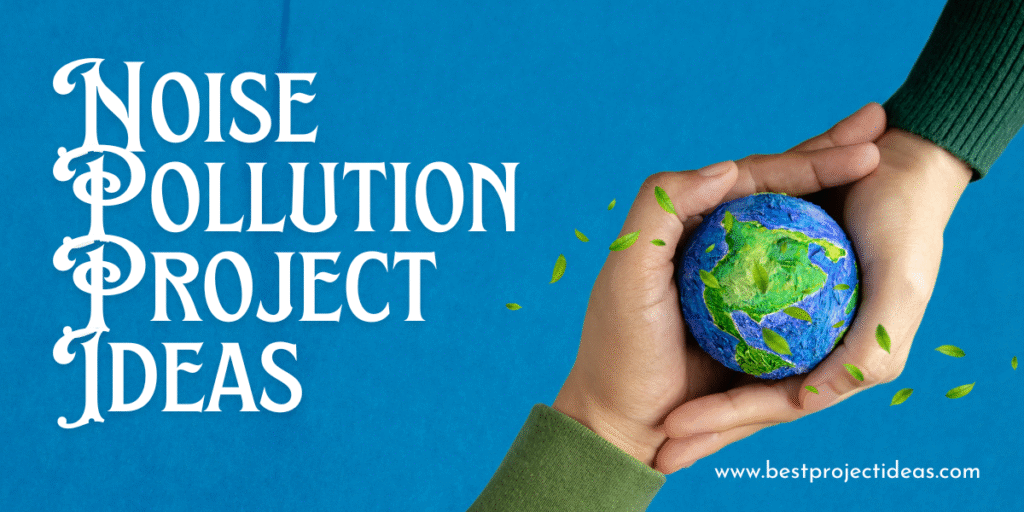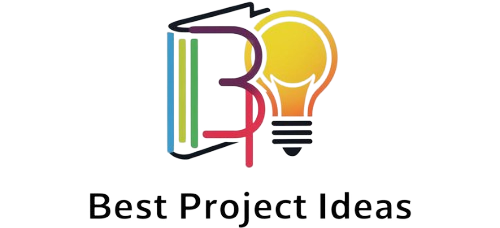
Noise surrounds us every day—from the rumble of traffic to the buzz of gadgets.
Yet, most of us overlook how this constant clamor can harm our health, wildlife, and overall well‑being. In this blog, you’ll discover a variety of hands‑on project ideas that explore what noise pollution is, why it matters, and how you can make a real difference through creative experiments and solutions.
Must Read: Informative 89+ Air Pollution Project Ideas 2025-26
Why Noise Pollution Project Ideas Matter
Noise pollution isn’t just an annoyance—it affects health, wildlife, and our quality of life. Tackling this invisible pollutant through projects can:
- Raise Awareness: Help people understand the hidden harm of excessive noise.
- Drive Innovation: Inspire new tools and techniques to reduce or monitor noise.
- Improve Well‑being: Lead to quieter, healthier environments in homes, schools, and cities.
What Is Noise Pollution?
Noise pollution refers to unwanted or harmful sound in our environment. Common sources include:
- Traffic and Transportation: Cars, trains, airplanes.
- Industrial Activities: Factories, construction sites.
- Everyday Electronics: Loudspeakers, household appliances.
Effects on Health and Environment
- Physical Stress: Headaches, high blood pressure.
- Hearing Damage: From prolonged exposure to loud sounds.
- Wildlife Disruption: Interferes with animal communication and behaviour.
How Do I Choose a Project Topic?
Selecting the right topic sets you up for success. Consider:
- Your Interests
- Do you enjoy electronics? Consider building a noise-level meter.
- Fascinated by biology? Study effects on local birds or frogs.
- Available Resources
- What equipment can you access? Microphones, data loggers, or even smartphone apps.
- Project Scope
- Keep it manageable. A small‑scale sound survey at your school or neighborhood can be as impactful as a complex prototype.
- Community Impact
- Aim for projects that benefit your surroundings—like a simple sound‑proofing demo for classrooms.
199+ Noise Pollution Project Ideas: 2025-26
Monitoring & Measurement
- Develop a smartphone app that uses the built‑in microphone to measure ambient noise levels and log location data.
- Build an Arduino‑based noise meter with an LCD display showing real‑time decibel readings.
- Create a Raspberry Pi network of sound sensors to map noise hotspots across your city.
- Design a wearable noise dosimeter to track personal exposure during a workday.
- Use Python and open data to visualize daily noise fluctuation patterns in different neighborhoods.
- Assemble a low‑cost DIY sound level meter using an ESP32 and send data to an online dashboard.
- Conduct a field study comparing smartphone decibel apps against professional sound level meters.
- Install community noise monitors at schools and analyze the impact of traffic during school hours.
- Develop a web scraper that collects local construction permits and correlates them with noise complaints.
- Use GIS software to overlay noise measurements with population density maps.
- Build a Bluetooth‑enabled noise sensor that alerts you when decibels exceed a preset threshold.
- Create a time‑lapse video showing hourly noise levels outside a hospital over one week.
- Develop a Slack bot that posts hourly noise level summaries for remote monitoring.
- Compare noise levels in buses, trains, and ride‑share vehicles during peak hours.
- Build an IoT device that uploads noise data to AWS and triggers email alerts for high readings.
- Use machine learning to classify noise sources (traffic, construction, voices) from recorded audio samples.
- Create a dashboard in Power BI visualizing noise trends over months in a busy market area.
- Conduct a citizen‑science campaign where residents use a shared app to upload noise readings.
- Measure noise attenuation inside ear protectors using a controlled sound chamber.
- Design a paper‑based acoustic sensor (using piezo film) and calibrate it against standard equipment.
- Build a solar‑powered outdoor noise monitor for long‑term unattended deployment.
- Develop a MATLAB script to analyze recorded audio files and extract peak decibel events.
- Test how different smartphone models vary in noise measurement accuracy.
- Create a public website displaying live noise level maps using Mapbox and sensor data.
- Measure indoor noise levels in classrooms and recommend seating arrangements for minimal exposure.
- Build a wearable badge for factory workers that buzzes when noise exceeds OSHA limits.
- Use Arduino and an SD card module to log 24‑hour noise level data for environmental analysis.
- Conduct a before‑and‑after study of noise levels along a street before and after speed bumps were installed.
- Develop a Node‑RED flow that aggregates noise data from multiple sensors and visualizes it.
- Measure the noise reduction provided by different window types in a home setting.
- Create an interactive map where users can vote on perceived noise annoyance at measured locations.
- Build a DIY sound‑activated LED strip that visually represents ambient noise intensity.
- Compare noise levels under various tree canopies to assess their buffering effect.
- Design an educational kit for schools to teach students about measuring and interpreting noise data.
- Program a microcontroller to classify loud noises and record timestamped events.
- Use Google Forms to collect subjective noise annoyance reports and compare against objective measurements.
- Build a cloud‑connected noise monitoring station powered by a small wind turbine.
- Develop a browser extension that shows current city noise levels using public sensor APIs.
- Measure the effect of different vehicle types on street‑level noise in a controlled test.
- Create a live Twitter feed that tweets local noise alerts when levels exceed healthy limits.
Mitigation Technologies
- Design a portable acoustic shield for power tools to reduce user noise exposure.
- Create a foam‑lined canopy for a lawn mower to cut noise by at least 3 dB.
- Build a noise‑cancelling enclosure for a school generator using recycled materials.
- Prototype an active noise cancellation helmet for construction workers.
- Test various DIY sound‑absorbing panels made from household items.
- Engineer a community bus shelter with noise‑reducing green walls.
- Develop a modular acoustic barrier for residential properties near highways.
- Design a passive noise‑reducing window insert that slips into existing frames.
- Build a noise‑dampening crate for delivery drones to reduce propeller noise.
- Prototype a quiet exhaust muffler for motorcycles using 3D‑printed baffles.
- Test different barrier heights and materials along a simulated railway track.
- Create a “sound garden” featuring vegetation strips and water features to mask urban noise.
- Develop a DIY acoustic canopy for classroom ceiling installations.
- Design a portable sound‑absorbing screen for home offices.
- Prototype an acoustic cloak for a small outdoor generator unit.
- Compare the effectiveness of various carpet underlays for floor noise reduction.
- Build a noise‑blocking mailbox enclosure for mail carriers.
- Test the noise‑reducing potential of recycled tire barriers along busy roads.
- Develop a 3D‑printed muffler insert for leaf blowers.
- Create a portable acoustic blanket for musicians to manage stage noise.
- Engineer a quiet fan housing with noise‑absorbing linings.
- Prototype a silent drone landing pad that dampens rotor noise.
- Test mass loaded vinyl curtains for noise control in recording studios.
- Design an acoustic planter box that doubles as a barrier and green feature.
- Build a sound‑absorbing bench for playgrounds using recycled plastics.
- Develop a noise‑reducing helmet liner for motorcyclists.
- Prototype a wind‑turbine shroud with acoustic dampers.
- Test biodegradable acoustic tiles for classroom walls.
- Create a foam‑filled acoustic baffle for retail checkout counters.
- Engineer a quiet air purifier housing using layered insulation.
- Build a noise‑attenuating picnic shelter for parks.
- Prototype acoustic wheels for hospital gurneys to reduce hallway noise.
- Compare different green roof designs for rooftop noise buffering.
- Develop a silent vacuum cleaner prototype with custom baffles.
- Design a modular sound‑absorbing fence panel for community gardens.
- Build an active noise cancellation system for open‑plan offices.
- Test sound‑absorbing paint additives in a home interior.
- Create a DIY acoustic ceiling cloud using recycled fabric.
- Prototype a soil‑filled acoustic berm along a model roadway.
- Engineer a noise‑mitigating bicycle frame to reduce road vibrations.
Urban Planning & Policy
- Analyze local zoning laws and propose new noise‑limit ordinances for mixed‑use areas.
- Conduct a case study on the impact of quiet pavement on neighborhood noise levels.
- Develop a GIS‑based tool to help planners locate noise‑sensitive land uses.
- Propose an updated noise contour map for your city’s airport environs.
- Survey public transit routes and recommend quieter bus corridor designs.
- Research the effectiveness of school buffer zones around busy roads.
- Draft model legislation for mandatory noise impact assessments in new developments.
- Compare noise standards across countries and recommend best practices.
- Evaluate the success of “quiet asphalt” pilot projects in reducing highway noise.
- Propose a citywide acoustic zoning plan, dividing areas by allowable decibel levels.
- Study the correlation between green spaces and ambient noise reduction in urban cores.
- Assess noise compliance at local construction sites and suggest policy improvements.
- Model the economic benefits of noise‑reduction measures for downtown revitalization.
- Create a toolkit for municipalities to conduct community noise audits.
- Examine night‑time noise regulations and their enforcement in entertainment districts.
- Propose a certification program for “quiet” public transportation vehicles.
- Analyze noise exposure disparities across socioeconomic groups in your city.
- Draft guidelines for noise‑sensitive building design in high‑rise residences.
- Investigate the impact of reduced speed limits on urban noise levels.
- Propose an incentive program for businesses to invest in quieter equipment.
- Research the role of noise in urban heat island effects and recommend policies.
- Assess the feasibility of curfews on non‑emergency vehicle sirens.
- Develop a community engagement framework for noise‑management plans.
- Compare enforcement strategies for noise violations in different municipalities.
- Analyze the cost‑benefit of installing sound barriers along commuter rail lines.
- Propose integration of acoustic considerations into city master plans.
- Investigate noise pollution near public hospitals and suggest policy remedies.
- Study the effect of increased green corridors on traffic noise in business districts.
- Draft a step‑by‑step guide for local councils to update noise bylaws.
- Assess the impact of ride‑share services on late‑night noise levels.
- Model projected noise increases under different urban growth scenarios.
- Propose noise fee structures for special events to fund mitigation measures.
- Compare private vs. public enforcement of noise regulations.
- Develop a public‑private partnership plan to fund urban noise barriers.
- Evaluate noise‑monitoring strategies used during large‑scale construction projects.
- Research the impact of pop‑up bike lanes on adjacent traffic noise.
- Propose integrating noise sensors into smart city infrastructure.
- Analyze the effectiveness of quiet zones around schools and hospitals.
- Draft a policy for mandatory acoustic certification of new vehicles.
- Assess public awareness of noise regulations and propose education campaigns.
Community Awareness & Education
- Organize a school workshop teaching students how to measure noise and interpret data.
- Create educational posters on the health impacts of noise for community centers.
- Develop a social‑media challenge encouraging residents to post quiet‑hour selfies.
- Host a “silent hour” event in a public park and document participants’ experiences.
- Produce a series of short videos explaining noise pollution causes and solutions.
- Design an interactive online quiz testing users’ knowledge about safe noise levels.
- Write a children’s storybook where characters explore a noisy city and find quiet spots.
- Develop a board game that simulates noise management decisions for city planners.
- Launch a neighborhood noise diary program, where volunteers log daily noise observations.
- Create infographics comparing common sounds to decibel levels for public distribution.
- Organize a “quiet commute” campaign promoting off‑peak travel times.
- Produce a podcast interviewing experts on noise mitigation strategies.
- Host a community art installation made of upcycled noise‑absorbing materials.
- Create a coloring book illustrating sources of noise and ways to reduce them.
- Design a classroom experiment demonstrating how sound travels through different media.
- Develop a DIY tutorial video on building a simple sound meter at home.
- Organize a poster contest on the theme “My Quiet City.”
- Launch a local hashtag (#QuietNeighborhood) to share peace‑and‑quiet photos.
- Create a brochure listing quiet walking and cycling routes in your area.
- Host a webinar for parents on protecting children’s hearing health.
- Develop a community pledge to reduce noise for one week and measure impact.
- Produce stickers for businesses showing their participation in a “Quiet Shop” initiative.
- Create a school assembly presentation on occupational noise hazards.
- Design an augmented‑reality app that visualizes invisible noise waves.
- Organize a noise‑pollution poster exhibit at the public library.
- Develop a citizen’s guide to filing noise complaints effectively.
- Host a “sound swap” event where people exchange noisy gadgets for quiet alternatives.
- Create classroom lesson plans aligning noise pollution topics with science curricula.
- Launch a local radio segment featuring daily quiet‑tips for residents.
- Produce an infographic map showing local quiet study spots for students.
- Organize a community sound walk, documenting sounds and noise sources together.
- Develop a toolkit for homeowners to assess and reduce indoor noise.
- Host a panel discussion with traffic engineers on reducing road noise.
- Create an online petition to install speed humps in residential streets.
- Design a mobile exhibit showcasing the anatomy of the human ear and noise damage.
- Launch a community blog where residents share their noise‑reduction successes.
- Produce educational bookmarks highlighting safe headphone volumes.
- Organize a “sound scavenger hunt” teaching kids to identify and record noises.
- Create a bilingual brochure on noise pollution for diverse communities.
- Host a neighborhood “quiet café” night with acoustic music only.
Biological & Health Impact Studies
- Conduct a survey on sleep quality before and after installation of window seals.
- Study children’s reading comprehension in quiet vs. noisy classroom settings.
- Measure stress hormone levels in volunteers after exposure to recorded traffic noise.
- Compare tinnitus prevalence among factory workers with and without hearing protection.
- Assess classroom attentiveness with varying background noise recordings.
- Study blood pressure changes in subjects listening to city noise for 30 minutes.
- Evaluate the impact of noise on bird nesting behavior in urban parks.
- Conduct audiometric tests on musicians before and after live performances.
- Research the effect of noise on plant growth rates in greenhouse experiments.
- Survey residents’ reported annoyance levels during different times of day.
- Compare cardiovascular health metrics in residents living near highways vs. quiet areas.
- Study the impact of neighborhood noise on elderly residents’ sleep patterns.
- Measure reaction times in drivers after exposure to sudden loud noises.
- Research links between chronic noise exposure and anxiety disorders.
- Conduct a case study of tinnitus management strategies in a clinic.
- Assess the effect of noise on balance and coordination in athletes.
- Study hearing threshold shifts in children using personal audio devices.
- Measure cognitive performance on puzzles under simulated construction noise.
- Research the impact of noise on heart rate variability in office workers.
- Compare stress levels in open‑plan vs. private office environments.
- Study the impact of traffic noise on amphibian call patterns at night.
- Measure blood oxygen levels in hospital patients in noisy vs. quiet wards.
- Research the effect of airport noise on residential property values and health.
- Conduct focus groups on perceived health impacts of noise in different age groups.
- Study immune response markers in subjects exposed to loud concerts.
- Evaluate the effect of noise‑reducing headphones on migraine frequency.
- Research correlations between noise exposure and incidence of hypertension.
- Measure learning retention in students after a quiet reading period vs. noisy break.
- Study crowd noise impact on sports performance in amateur athletes.
- Assess the auditory processing speed in children from quiet vs. noisy neighborhoods.
- Conduct a longitudinal study on sleep disturbance in urban vs. rural settings.
- Measure stress recovery rates in participants resting in quiet rooms vs. city noise recordings.
- Research the impact of construction noise on local wildlife diversity.
- Study the influence of white noise machines on infant sleep quality.
- Assess noise‑related hearing loss prevalence in urban street vendors.
- Measure cortisol levels in office workers using noise‑cancelling versus open‑ear solutions.
- Study the impact of noise on language acquisition in bilingual children.
- Research the effect of continuous noise exposure on digestive health in lab animals.
- Compare brainwave patterns in participants relaxing with and without background noise.
- Investigate the link between nighttime noise and metabolic syndrome markers.
Tips for a Successful Project
- Plan Thoroughly: Outline objectives, methods, and equipment before you start.
- Keep Records: Document measurements, observations, and challenges.
- Test and Iterate: Prototype early, learn from mistakes, and improve your design.
- Engage Others: Present your work to classmates, teachers, or community members for feedback.
Discover More: Top 367+ Pollution Project Ideas: Simple, Impactful Science Projects for Students
Conclusion
Tackling noise pollution doesn’t require a fancy lab—just curiosity, some simple tools, and a willingness to explore.
Whether you build your own sound meter, survey your neighborhood, or test natural barriers, each project helps shine a light on an often‑ignored problem.
Dive in, experiment, and share your findings—you’ll be contributing to quieter, healthier spaces for everyone!

